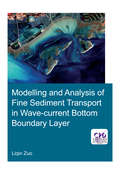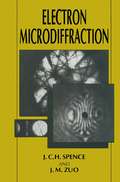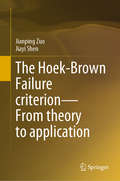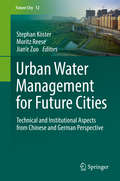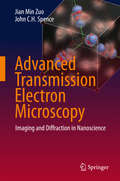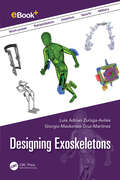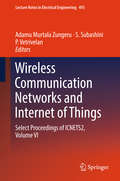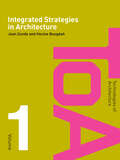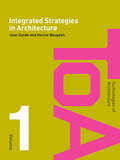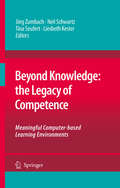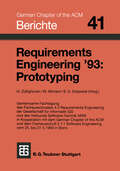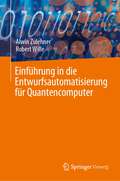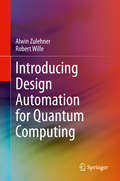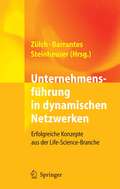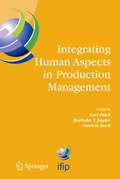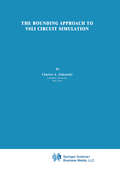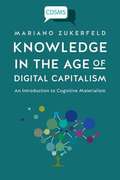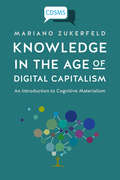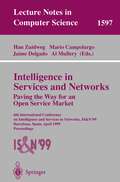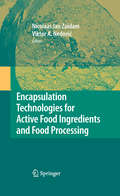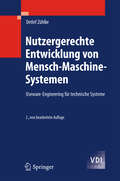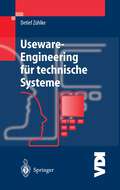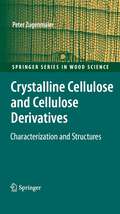- Table View
- List View
Modelling and Analysis of Fine Sediment Transport in Wave-Current Bottom Boundary Layer (IHE Delft PhD Thesis Series)
by Liqin ZuoThe evolution and utilization of estuarine and coastal regions are greatly restricted by sediment problems. This thesis aims to better understand fine sediment transport under combined action of waves and currents, especially in the wave-current bottom boundary layer (BBL). Field observations, experimental data analysis, theoretical analysis and numerical models are employed. Silt-dominated sediments are sensitive to flow dynamics and the suspended sediment concentration (SSC) increase rapidly under strong flow dynamics. This research unveils several fundamental aspects of silty sediment, i.e., the criterion of the incipient motion, the SSC profiles and their phase-averaged parameterization in wave-dominated conditions. An expression for sediment incipient motion is proposed for silt-sand sediment under combined wave and current conditions. A process based intra-wave 1DV model for flow-sediment dynamics near the bed is developed in combined wave-current conditions. The high concentration layer (HCL) was simulated and sensitivity analysis was carried out by the 1DV model on factors that impact the SSC in the HCL. Finally, based on the 1DV model, the formulations of the mean SSC profile of silt-sand sediments in wave conditions were proposed. The developed approaches are expected to be applied in engineering practice and further simulation.
Modelling and Analysis of Fine Sediment Transport in Wave-Current Bottom Boundary Layer (IHE Delft PhD Thesis Series)
by Liqin ZuoThe evolution and utilization of estuarine and coastal regions are greatly restricted by sediment problems. This thesis aims to better understand fine sediment transport under combined action of waves and currents, especially in the wave-current bottom boundary layer (BBL). Field observations, experimental data analysis, theoretical analysis and numerical models are employed. Silt-dominated sediments are sensitive to flow dynamics and the suspended sediment concentration (SSC) increase rapidly under strong flow dynamics. This research unveils several fundamental aspects of silty sediment, i.e., the criterion of the incipient motion, the SSC profiles and their phase-averaged parameterization in wave-dominated conditions. An expression for sediment incipient motion is proposed for silt-sand sediment under combined wave and current conditions. A process based intra-wave 1DV model for flow-sediment dynamics near the bed is developed in combined wave-current conditions. The high concentration layer (HCL) was simulated and sensitivity analysis was carried out by the 1DV model on factors that impact the SSC in the HCL. Finally, based on the 1DV model, the formulations of the mean SSC profile of silt-sand sediments in wave conditions were proposed. The developed approaches are expected to be applied in engineering practice and further simulation.
Electron Microdiffraction
by J.M. Zuo J.C.H. SpenceMuch of this book was written during a sabbatical visit by J. C. H. S. to the Max Planck Institute in Stuttgart during 1991. We are therefore grateful to Professors M. Ruhle and A. Seeger for acting as hosts during this time, and to the Alexander von Humbolt Foundation for the Senior Scientist Award which made this visit possible. The Ph. D. work of one of us (J. M. Z. ) has also provided much of the background for the book, together with our recent papers with various collaborators. Of these, perhaps the most important stimulus to our work on convergent-beam electron diffraction resulted from a visit to the National Science Foundation's Electron Microscopy Facility at Arizona State University by Professor R. H(lJier in 1988, and from a return visit to Trondheim by J. C. H. S. in 1990. We are therefore particularly grateful to Professor H(lJier and his students and co-workers for their encouragement and collaboration. At ASU, we owe a particular debt of gratitude to Professor M. O'Keeffe for his encouragement. The depth of his under standing of crystal structures and his role as passionate skeptic have frequently been invaluable. Professor John Cowley has also been an invaluable sounding board for ideas, and was responsible for much of the experimental and theoretical work on coherent nanodiffraction. The sections on this topic derive mainly from collaborations by J. C. H. S. with him in the seventies.
The Hoek-Brown Failure criterion—From theory to application
by Jianping Zuo Jiayi ShenThis book provides a comprehensive coverage of the theory and principle of the Hoek-Brown (HB) failure criterion, methods or guidelines for estimating the HB input parameters, and the methodology of application of the HB criterion in rock engineering projects. It aims to help researchers, engineers and research students who work in the area of rock mechanics and mining engineering. Academics can quickly obtain an overview of the state of the art of the theory and principle of the Hoek-Brown criterion by reading the book before they advance their researches on the topics related to rock failure criteria. Geotechnical engineers can select appropriate Hoek-Brown input parameters for the design and analysis of rock engineering projects with the help of the principles introduced in this book. Research students may use the book as a textbook to learn the principle of rock mechanics related to rock mass properties.
Urban Water Management for Future Cities: Technical and Institutional Aspects from Chinese and German Perspective (Future City #12)
by Jiane Zuo Moritz Reese Stephan KösterThis book features expert contributions on key sustainability aspects of urban water management in Chinese agglomerations. Both technical and institutional pathways to sustainable urban water management are developed on the basis of a broad, interdisciplinary problem analysis.
Advanced Transmission Electron Microscopy: Imaging and Diffraction in Nanoscience
by Jian Min Zuo John C.H. SpenceThis volume expands and updates the coverage in the authors' popular 1992 book, Electron Microdiffraction. As the title implies, the focus of the book has changed from electron microdiffraction and convergent beam electron diffraction to all forms of advanced transmission electron microscopy. Special attention is given to electron diffraction and imaging, including high-resolution TEM and STEM imaging, and the application of these methods to crystals, their defects, and nanostructures. The authoritative text summarizes and develops most of the useful knowledge which has been gained over the years from the study of the multiple electron scattering problem, the recent development of aberration correctors and their applications to materials structure characterization, as well as the authors' extensive teaching experience in these areas. Advanced Transmission Electron Microscopy: Imaging and Diffraction in Nanoscience is ideal for use as an advanced undergraduate or graduate level text in support of course materials in Materials Science, Physics or Chemistry departments.
Designing Exoskeletons
by Luis Adrian Zuñiga-Aviles Giorgio Mackenzie Cruz-MartinezDesigning Exoskeletons focuses on developing exoskeletons, following the lifecycle of an exoskeleton from design to manufacture. It demonstrates how modern technologies can be used at every stage of the process, such as design methodologies, CAD/CAE/CAM software, rapid prototyping, test benches, materials, heat and surface treatments, and manufacturing processes. Several case studies are presented to provide detailed considerations on developing specific topics. Exoskeletons are designed to provide work-power, rehabilitation, and assistive training to sports and military applications. Beginning with a review of the history of exoskeletons from ancient to modern times, the book builds on this by mapping out recent innovations and state-of-the-art technologies that utilize advanced exoskeleton design. Presenting a comprehensive guide to computer design tools used by bioengineers, the book demonstrates the capabilities of modern software at all stages of the process, looking at computer-aided design, manufacturing, and engineering. It also details the materials used to create exoskeletons, notably steels, engineering polymers, composites, and emerging materials. Manufacturing processes, both conventional and unconventional are discussed—for example, casting, powder metallurgy, additive manufacturing, and heat and surface treatments. This book is essential reading for those in the field of exoskeletons, such as designers, workers in research and development, engineering and design students, and those interested in robotics applied to medical devices.
Designing Exoskeletons
by Luis Adrian Zuñiga-Aviles Giorgio Mackenzie Cruz-MartinezDesigning Exoskeletons focuses on developing exoskeletons, following the lifecycle of an exoskeleton from design to manufacture. It demonstrates how modern technologies can be used at every stage of the process, such as design methodologies, CAD/CAE/CAM software, rapid prototyping, test benches, materials, heat and surface treatments, and manufacturing processes. Several case studies are presented to provide detailed considerations on developing specific topics. Exoskeletons are designed to provide work-power, rehabilitation, and assistive training to sports and military applications. Beginning with a review of the history of exoskeletons from ancient to modern times, the book builds on this by mapping out recent innovations and state-of-the-art technologies that utilize advanced exoskeleton design. Presenting a comprehensive guide to computer design tools used by bioengineers, the book demonstrates the capabilities of modern software at all stages of the process, looking at computer-aided design, manufacturing, and engineering. It also details the materials used to create exoskeletons, notably steels, engineering polymers, composites, and emerging materials. Manufacturing processes, both conventional and unconventional are discussed—for example, casting, powder metallurgy, additive manufacturing, and heat and surface treatments. This book is essential reading for those in the field of exoskeletons, such as designers, workers in research and development, engineering and design students, and those interested in robotics applied to medical devices.
Wireless Communication Networks and Internet of Things: Select Proceedings of ICNETS2, Volume VI (Lecture Notes in Electrical Engineering #493)
by Adamu Murtala Zungeru S Subashini P VetrivelanThis book is a collection of papers from international experts presented at International Conference on NextGen Electronic Technologies (ICNETS2-2016). ICNETS2 encompassed six symposia covering all aspects of electronics and communications domains, including relevant nano/micro materials and devices. Presenting recent research on wireless communication networks and Internet of Things, the book will prove useful to researchers, professionals and students working in the core areas of electronics and their applications, especially in signal processing, embedded systems and networking.
Integrated Strategies in Architecture
by Joan Zunde Hocine BougdahThis key text presents students with a holistic view of the building design process, bridging the gap between the theory and practice of constructing and assembling buildings. Integrated Strategies in Architecture encourages and enables students to gain a sound understanding of the purpose of buildings, the specialisms that contribute and the available technology. Zunde and Bougdah thoroughly introduce and expose the concepts and technologies that underlie the design process, setting current design in context as part of an evolutionary process, exemplified through historic and contemporary models, and emphasizing the importance of applying a broad variety of technologies in the creation of successful buildings. Topics covered include: space planning, colour theory, communication, management, aesthetics, structures and environmental control. This essential text will greatly assist students of architecture and its technology, construction management and building surveying as well as practitioners as they strive to build better buildings.
Integrated Strategies in Architecture
by Joan Zunde Hocine BougdahThis key text presents students with a holistic view of the building design process, bridging the gap between the theory and practice of constructing and assembling buildings. Integrated Strategies in Architecture encourages and enables students to gain a sound understanding of the purpose of buildings, the specialisms that contribute and the available technology. Zunde and Bougdah thoroughly introduce and expose the concepts and technologies that underlie the design process, setting current design in context as part of an evolutionary process, exemplified through historic and contemporary models, and emphasizing the importance of applying a broad variety of technologies in the creation of successful buildings. Topics covered include: space planning, colour theory, communication, management, aesthetics, structures and environmental control. This essential text will greatly assist students of architecture and its technology, construction management and building surveying as well as practitioners as they strive to build better buildings.
Beyond Knowledge: Meaningful Computer-based Learning Environments
by Jörg Zumbach Liesbeth Kester Neil Schwartz Tina SeufertThe edited and peer reviewed volume presents selected papers of the conference “Beyond knowlegde: the legacy of competence” organized by EARLI SIG Learning and Instruction with Computers in cooperation with SIG Instructional Design. It reflects the current state-of-the-art work of scholars worldwide within the area of learning and instruction with computers. Mainly, areas of computer-based learning environments supporting competence-focused knowledge acquisition but also foundational scientific work are addressed. More specific, contents cover cognitive processes in hypermedia and multimedia learning, social issues in computer-supported collaborative learning, motivation and emotion in Blended Learning and e-Learning.
Requirements Engineering ’93: Prototyping (Berichte des German Chapter of the ACM)
by Züllighoven Altmann DoberkatEinführung in die Entwurfsautomatisierung für Quantencomputer
by Alwin Zulehner Robert WilleDieses Buch bietet dem Leser einen einfachen Einstieg in das Quantencomputing sowie in den Entwurf entsprechender Geräte. Die Autoren behandeln verschiedene Entwurfsaufgaben, die für das Quantencomputing wichtig sind, und stellen entsprechende Lösungen vor. Eine Besonderheit des Buches ist, dass diese Aufgaben und Lösungen explizit aus der Perspektive der Entwurfsautomatisierung diskutiert werden, d.h. unter Verwendung von cleveren Algorithmen und Datenstrukturen, die von der Entwurfsautomatisierungs-Community für konventionelle Logik (d.h. für elektronische Geräte und Systeme) entwickelt worden sind und nun für diese neue Technologie angewendet werden. Auf diese Weise können relevante Entwurfsaufgaben wesentlich effizienter als bisher durchgeführt werden, was zu Verbesserungen um mehrere Größenordnungen führt (in Bezug auf die Laufzeit und andere Entwurfsziele). Beschreibt den aktuellen Stand der Technik für den Entwurf von Quantenschaltungen, für deren Simulation und für deren Abbildung auf reale Hardware; Bietet eine erste umfassende Einführung in die Entwurfsautomatisierung für Quantencomputer, die sich mit praxisrelevanten Aufgabenstellungen befasst; Es richtet sich sowohl an die Quantencomputer-Gemeinschaft als auch an die Gemeinschaft der Entwurfsautomatisierung und zeigt, welche beeindruckenden Verbesserungen möglich sind, wenn man das Wissen beider Gemeinschaften kombiniert.
Introducing Design Automation for Quantum Computing
by Alwin Zulehner Robert WilleThis book offers readers an easy introduction into quantum computing as well as into the design for corresponding devices. The authors cover several design tasks which are important for quantum computing and introduce corresponding solutions. A special feature of the book is that those tasks and solutions are explicitly discussed from a design automation perspective, i.e., utilizing clever algorithms and data structures which have been developed by the design automation community for conventional logic (i.e., for electronic devices and systems) and are now applied for this new technology. By this, relevant design tasks can be conducted in a much more efficient fashion than before – leading to improvements of several orders of magnitude (with respect to runtime and other design objectives).Describes the current state of the art for designing quantum circuits, for simulating them, and for mapping them to real hardware;Provides a first comprehensive introduction into design automation for quantum computing that tackles practically relevant tasks;Targets the quantum computing community as well as the design automation community, showing both perspectives to quantum computing, and what impressive improvements are possible when combining the knowledge of both communities.
Unternehmensführung in dynamischen Netzwerken: Erfolgreiche Konzepte aus der Life-Science-Branche
by Joachim Zülch Luis Barrantes Sylvia SteinheuserDynamische Netzwerkbildung gilt als effektive Antwort auf die wachsende Verflechtung der Weltmärkte. Doch vielfach hapert es gerade in Kleinst- und kleinen Unternehmen am erforderlichen Know-how. Hier setzen die Autoren an: aus der Perspektive des Unternehmers und in der Sprache des Praktikers. Wissenschaftlich fundierte Kenntnisse und praktische Lösungsvorschläge unterstützen nachhaltig unternehmerisches Engagement in dynamischen Netzwerken.
Integrating Human Aspects in Production Management: IFIP TC5 / WG5.7 Proceedings of the International Conference on Human Aspects in Production Management 5-9 October 2003, Karlsruhe, Germany (IFIP Advances in Information and Communication Technology #160)
by Gert Zülch Harinder Singh Jagdev Patricia StockIn recent years the situation of production enterprises has been aggravated by the change from a vendors' market to a buyers' market, the globaHsation of competition, a severe market segmentation and rapid progress in product and process technologies. Beside cost and quality, time has taken on an increasingly important role, forcing enterprises to become ever more dynamic and versatile. Therefore, in all areas of production management, novel, effective concepts, procedures and tools have been developed in order to meet these new requirements. But beyond these more technical, organisational and information technology related aspects there is certainly another one which has to be considered more closely than ever before, namely that of human resources. Is not group technology also related to group work? Do partners in a global network only operate according to predefined process schemes with no personal contact? Are the mental process models of the programmers of ERP-systems the same as those of the users? What is the impact of human behaviour and what consequences are to be expected if organisational and individual objectives are separated? And finally, how do necessary technological changes affect the workforce and the individual needs and wishes of the employees.
The Bounding Approach to VLSI Circuit Simulation (The Springer International Series in Engineering and Computer Science #17)
by C.A. ZukowskiThis book proposes a new approach to circuit simulation that is still in its infancy. The reason for publishing this work as a monograph at this time is to quickly distribute these ideas to the research community for further study. The book is based on a doctoral dissertation undertaken at MIT between 1982 and 1985. In 1982 the author joined a research group that was applying bounding techniques to simple VLSI timing analysis models. The conviction that bounding analysis could also be successfully applied to sophisticated digital MOS circuit models led to the research presented here. Acknowledgments 'me author would like to acknowledge many helpful discussions and much support from his research group at MIT, including Lance Glasser, John Wyatt, Jr. , and Paul Penfield, Jr. Many others have also contributed to this work in some way, including Albert Ruchli, Mark Horowitz, Rich Zippel, Chtis Terman, Jacob White, Mark Matson, Bob Armstrong, Steve McCormick, Cyrus Bamji, John Wroclawski, Omar Wing, Gary Dare, Paul Bassett, and Rick LaMaire. The author would like to give special thanks to his wife, Deborra, for her support and many contributions to the presentation of this research. The author would also like to thank his parents for their encouragement, and IBM for its financial support of t,I-Jis project through a graduate fellowship. THE BOUNDING APPROACH TO VLSI CIRCUIT SIMULATION 1. INTRODUCTION The VLSI revolution of the 1970's has created a need for new circuit analysis techniques.
Knowledge In The Age Of Digital Capitalism: An Introduction To Cognitive Materialism (Critical Digital and Social Media Studies #2)
by Mariano ZukerfeldKnowledge in the Age of Digital Capitalism proposes a new critical theory concerning the functioning of capitalism and how we consider knowledge and information. This ambitious book systematically and lucidly introduces contemporary phenomena into the framework of cognitive materialism to address some of the great themes of the social sciences: knowledge, exploitation and social class in an account of capitalism’s totality in the present day. Author Mariano Zukerfeld reinvigorates materialist study of communications, presenting a typology of knowledge to explain the underlying material forms of information, intellectual property and cognitive work in contemporary societies. Using current examples the book also examines concerns such as free labour and the pivotal role of intellectual property.
Knowledge in the Age of Digital Capitalism: An Introduction to Cognitive Materialism (Critical Digital and Social Media Studies #2)
by Mariano ZukerfeldKnowledge in the Age of Digital Capitalism proposes a new critical theory concerning the functioning of capitalism and how we consider knowledge and information. This ambitious book systematically and lucidly introduces contemporary phenomena into the framework of cognitive materialism to address some of the great themes of the social sciences: knowledge, exploitation and social class in an account of capitalism’s totality in the present day. Author Mariano Zukerfeld reinvigorates materialist study of communications, presenting a typology of knowledge to explain the underlying material forms of information, intellectual property and cognitive work in contemporary societies. Using current examples the book also examines concerns such as free labour and the pivotal role of intellectual property. The book offers nothing less than an introduction to the theory of cognitive materialism and an account of the entirety of the digital (or knowledge) capitalism of our time. 'A sustained and well-informed critical philosophical study of knowledge in society and capitalism.' Professor Christian Fuchs, CDSMS series editor and author of Critical Theory of Communication and Social Media: A Critical Introduction. 'A bold, comprehensive theoretical book, offering a new understanding of knowledge and its role in capitalism, historically, and today.' Dr Eran Fisher, author of Media and New Capitalism in the Digital Age: The Spirit of Networks.
Intelligence in Services and Networks. Paving the Way for an Open Service Market: 6th International Conference on Intelligence and Services in Networks, IS&N'99, Barcelona, Spain, April 27-29, 1999, Proceedings (Lecture Notes in Computer Science #1597)
by Han Zuidweg Mario Campolargo Jaime Delgado Al MulleryPaving the Way for an Open Service Market We live in an age when powerful communications technology is becoming available to everyone. From our home we can send and receive not only analogue voice, but also growing volumes of digital information and even intelligence in the form of agents. We are becoming increasingly mobile and are expecting the same level of connectivity in the home, in the office, and on the road. The regulatory and commercial environment in which we communicate is changing. The telecommunications market is becoming increasingly competitive. The Internet is erasing the borders between information technology and telecommunications. And the way we do business is ever more dominated by electronic exchanges of information. Is our technology ready for the open market of networks and services? Can we manage the growing complexity of computing and telecommunications technology and place it at the service of the people? The challenge for the research community is to develop the tools and techniques that will ultimately bring the full power of communications and information to everyone, in a way that everyone can easily use. The Sixth International Conference on Intelligence in Services and Networks (IS&N’99) is all about technology for paving the way to the open services market. Since the first IS&N conference in 1992 the focus of the IS&N program has continually shifted. We see existing technologies maturing while new ones emerge, but the bottom line has always been putting technology at the service of the people.
Encapsulation Technologies for Active Food Ingredients and Food Processing
by N. J. Zuidam Viktor NedovicConsumers prefer food products that are tasty, healthy, and convenient. Encapsulation is an important way to meet these demands by delivering food ingredients at the right time and right place. For example, encapsulates may allow flavor retention, mask bad tasting or bad smelling components, stabilize food ingredients, and increase their bioavailability. Encapsulation may also be used to immobilize cells or enzymes in the production of food materials or products, such as fermentation or metabolite production. This book provides a detailed overview of the encapsulation technologies available for use in food products, food processing, and food production. The book aims to inform those who work in academia or R&D about both the delivery of food compounds via encapsulation and food processing using immobilized cells or enzymes. The structure of the book is according to the use of encapsulates for a specific application. Emphasis is placed on strategy, since encapsulation technologies may change. Most chapters include application possibilities of the encapsulation technologies in specific food products or processes. The first part of the book reviews general technologies, food-grade materials, and characterization methods for encapsulates.The second part discusses encapsulates of active ingredients (e.g., aroma, fish oil, minerals, vitamins, peptides, proteins, probiotics) for specific food applications.The last part describes immobilization technologies of cells and enzymes for use within food fermentation processes (e.g., beer, wine, dairy, meat), and food production (e.g., sugar conversion, production of organic acids or amino acids, hydrolysis of triglycerides).Edited by two leading experts in the field, Encapsulation Technologies for Food Active Ingredients and Food Processing will be a valuable reference source for those working in the academia or food industry. The editors work in both industry or academia, and they have brought together in this book contributions from both fields.
Nutzergerechte Entwicklung von Mensch-Maschine-Systemen: Useware-Engineering für technische Systeme (VDI-Buch)
by Detlef ZühlkeDas Buch gibt Entwicklern einen Leitfaden zur nutzergerechten Gestaltung von Mensch-Maschine-Systemen an die Hand. Dabei werden die besonderen Gestaltungsprobleme von Useware-Systemen für internationale Märkte ebenso behandelt wie die Auswahl von Entwicklungstools, Normen und Richtlinien sowie grundlegende Gestaltungsregeln. Wichtige Neuerungen, etwa die modellbasierte Entwicklung von Benutzungsschnittstellen oder zukünftige Interaktionsformen, werden in der Neuauflage anhand von Gestaltungsbeispielen vorgestellt.
Useware-Engineering für technische Systeme (VDI-Buch)
by Detlef ZühlkeMit dem Begriff Useware ist eine Fokussierung der Technikgestaltung auf menschliche Fähigkeiten und Bedürfnisse an der Mensch-Maschine-Schnittstelle verbunden. Das Buch hilft Entwicklern in der Industrie und Forschung mit praktisch orientierten Beispielen für Gestaltungslösungen. Eine kurze Erläuterung der menschlichen Fähigkeiten erhöht das Verständnis für die Vorgehensweise bei der Gestaltung komplexer Useware-Systeme, die detailliert dargestellt wird.
Crystalline Cellulose and Derivatives: Characterization and Structures (Springer Series in Wood Science)
by Peter ZugenmaierCellulose as an abundant renewable material has stimulated basic and applied research that has resulted in significant progress in polymer science. This book discusses reliable crystal structures of all cellulose polymorphs and cellulose derivatives. Models are represented in graphs, together with a collection of geometrical data and the atomic coordinates. This book is a concise guide for members of the materials and life sciences communities interested in cellulose and related materials.
